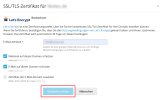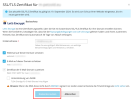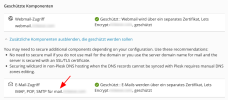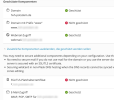- Server operating system version
- Ubuntu 24.04.1 LTS
- Plesk version and microupdate number
- Plesk Obsidian 18.0.66 Update 2
Hello!
For the last while I have been separating domains for www and mail on two separate Plesk servers.
This results in a lot of manual effort for the renewal of certificates (Lets Encrypt). This is certainly even more inconvenient for me as I operate an external DNS server.
The external DNS server is fully set up. The renewal of the certificate on the Plesk for www is done via DNS entry (_acme-challenge.domain.tld) and works so far.
On the second Plesk server, the domain is set up so that the mx record of domain.tld is reached, mail works. There is also the DNS entry mail.domain.tld as an alias for the customers (IMAP, SMTP) and webmail.domain.tld as an entry point for Roundcube.
Problem: I cannot renew the certificate on the second Plesk because Lets Encrypt uses the IP of the first Plesk for domain.tld and not mail.domain.tld or webmail.domain.tld
Alternatively, I can of course point domain.tld to the second server at the time of renewal, but this may not be a solution for many domains.
Can I perhaps use the CLI to renew the certificate on the second server or is there a “HowTo” for such configurations, which I have not found so far?
If I only have sub-domains on the first (www) Plesk server, this is all easy, as I can then generate the certificates there using a dedicated _acme-challenge.sub.domain.tld.
Thanks for any advice!
For the last while I have been separating domains for www and mail on two separate Plesk servers.
This results in a lot of manual effort for the renewal of certificates (Lets Encrypt). This is certainly even more inconvenient for me as I operate an external DNS server.
The external DNS server is fully set up. The renewal of the certificate on the Plesk for www is done via DNS entry (_acme-challenge.domain.tld) and works so far.
On the second Plesk server, the domain is set up so that the mx record of domain.tld is reached, mail works. There is also the DNS entry mail.domain.tld as an alias for the customers (IMAP, SMTP) and webmail.domain.tld as an entry point for Roundcube.
Problem: I cannot renew the certificate on the second Plesk because Lets Encrypt uses the IP of the first Plesk for domain.tld and not mail.domain.tld or webmail.domain.tld
Alternatively, I can of course point domain.tld to the second server at the time of renewal, but this may not be a solution for many domains.
Can I perhaps use the CLI to renew the certificate on the second server or is there a “HowTo” for such configurations, which I have not found so far?
If I only have sub-domains on the first (www) Plesk server, this is all easy, as I can then generate the certificates there using a dedicated _acme-challenge.sub.domain.tld.
Thanks for any advice!





